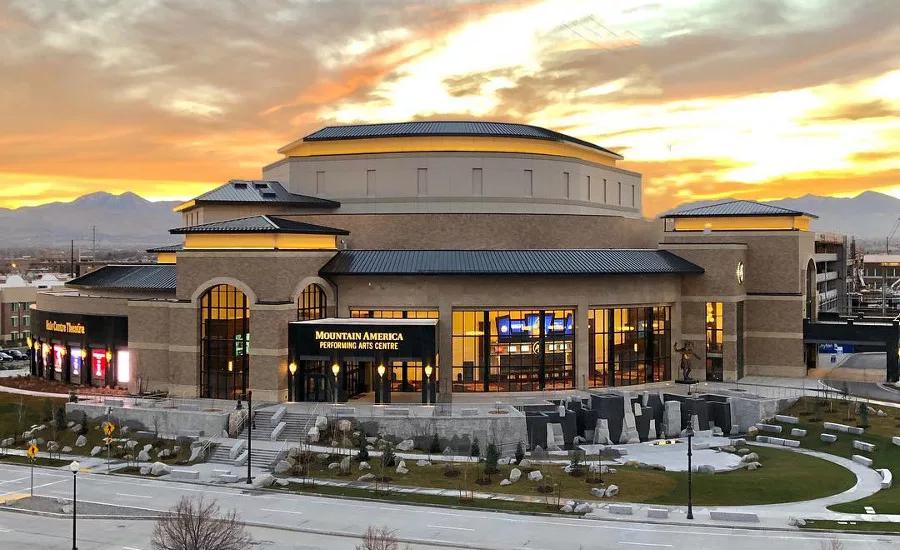Hale Centre Theatre Unique Roof Design Keeps Water, Noise Out
The roof above the new, $80 million Hale Centre Theatre in Sandy, Utah uses acoustical smoke vents to limit noise and water.

Architects at Beecher Walker in Holladay, Utah faced a roofing challenge and more in the construction of the $80 million Hale Centre Theatre in Sandy, Utah.
Baseball fans at Shea Stadium, the former home of the New York Mets, used to cover their ears with their hands when jets departing and returning to nearby LaGuardia Airport rumbled overhead. While not as noticeable at their new stadium, Citi Field, the team’s fans still hear the roar of aircraft at home games. Loud airplanes directly can reduce viewing pleasure of anyone, but especially those attending theater performances.
Architects at Beecher Walker in Holladay, Utah faced that roofing challenge and more in the construction of the $80 million Hale Centre Theatre in Sandy, Utah. Besides being positioned directly in the flight path of a nearby airport, the theater sits adjacent to Interstate 15, where 260,000 vehicles pass daily. “The sound issues were pretty intense,’’ architect Lyle Beecher said. “We knew it was going to be an issue.”
Beecher and his team addressed the problems with 20 acoustical smoke vents at the suggestion of Zack Williams of Cannon Sales in Centreville, Utah. Heritage Roofing of Bluffdale, Utah, installed the smoke vents, which included 24 volt electric thermolatches. The smoke vents feature an STC-46 acoustical sound rating, which guard against noise intrusion.
"There are also helicopters that fly directly overhead,’’ Beecher said. “The air traffic was one of the primary concerns that we had when we discussed what roofing components we would use. Those acoustical smoke vents are the only thing that is stopping noise from the outside at the loading level. We couldn’t have any noise infiltrating the building.”
The smoke vents are commonly used in concert halls, theaters and other interior applications that restrict noise from the outside.
The vents did more, however, than stop noise intrusion. They’re also a critical part to the safety of the patrons at the theatre. The Hale Centre includes two theaters that can accommodate 1,368 guests. The Sorenson Legacy Jewel Box Stage offers a seating capacity of 467, while the Centre Stage has a capacity of 901. In all, the Hale Centre, which is officially named the Mountain America Performing Arts Centre, covers 133,000 square feet.
The vents include gas spring operators that open the covers in snow and wind. They also have built-in dampers to assure smooth opening and eliminate the possibility of operational, roofing or structural damage.
“The vents solved a tremendous challenge for us,’’ Beecher said. “The most important thing is to make sure people are safe. Those vents create a passive smoke ventilation system that leads up through the loading level. It keeps the smoke out of the theater so that everyone can exit safely.”
Any building can be subject to a fire, but history has proven that theaters can be particularly vulnerable. Tait Towers, which assisted Beecher Walker in construction of the stage at the theater, developed the most technologically sophisticated stage in the world for the Hale Centre. It includes ascending and descending stages, 47 axes of motion using more than 130 motors for hoisting, lifting, sliding and rotating, and two crane trolleys that sit high above the Centre Stage. All the technological wizardry, while safe when used properly, increases the potential for fire.
Stage technology has become so advanced that the Fire Protection Research Foundation wrote a report in 2009 that addressed fire protective measures at theaters. One of the findings of the report said, “It is desirable that a fire safety curtain and roof vents are activated prior to sprinklers,” and that the vents “Are tied to a relatively responding rate-of-rise heat detectors, preferably ceiling mounted.” Bilco’s vents automatically release upon the melting of a UL-listed 165°F fusible link. The gas springs include integral dampers to assure the covers open at a controlled rate. They are also insulated and gasketed for weather-tightness.
“They were such an important part of this,’’ Beecher said. “We know that they will operate if there is an actual fire. We needed to make sure that if a fire did occur, everyone could exit safely.”
The smoke vents were just one architectural element that makes the Hale Center special. The stage wizardry will engross theater audiences, who will also enjoy covered parking for 1,750 vehicles, six giant LED screens, 32 women’s restroom stalls and six inches of extra leg room in the theaters. The theater plans to host 700 performances over the two stages during the year.
“To take the finishing touches to the level that they are was a pretty good challenge,’’ Beecher said. “We’re talking about a lot of specialized components.”
Mark Dietlein, the president, CEO and executive director of the Hale Centre said the center’s board of directors decided to construct a new facility in 2015. Its former 613-seat home in nearby West Valley played to 100 percent capacity audiences for 11 years, which triggered the need for a bigger theater. “The only option was to increase prices,’’ said Dietlein, the grandson of the theatre’s founders, Ruth and Nathan Hale, and the President of the theater since 1985. “The prices would have increased so much that they would have been beyond the reach for a lot of families. To preserve the option for great theater, we started to look at the option for more seats.”
The Sorenson Legacy Jewel Box Stage opened in September, and the first performance at Centre Stage took place in November. The Hale Centre is one of the jewels of the Salt Lake City region, which is quickly becoming recognized as a cultural hub. Building is also especially strong in Utah, as construction jobs posted a 6.8 increase in 2016.
Now, residents of Sandy and nearby regions have a world-class theatre to witness amazing theatrical performances. And they won’t have to cover their ears when an airplane clamors overhead or worry about dealing with smoke-filled egress in the event of emergency.
“When we first discussed this project, it was a combination of apprehension and excitement,’’ Beecher said. “This is a career project. It’s something that is unlike any other place in the world. I think of the Hale Centre as one of the main actors in the play. It’s an honor to have been part of it.”
Looking for a reprint of this article?
From high-res PDFs to custom plaques, order your copy today!



